Best Chicken Coop Designs
Best Chicken Coop Designs: Cool New 2024 DIY Chicken Coop Plans & Ideas
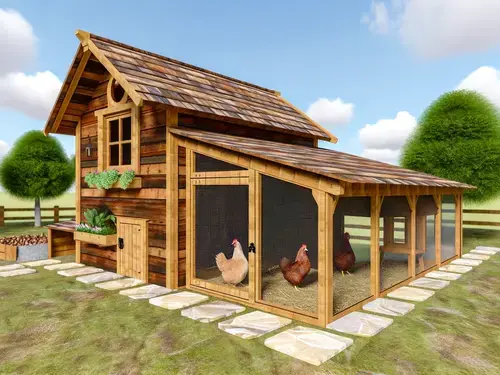
What to Expect in This Article The fascinating chicken coop designs:
- Historic Hen Houses: How chicken coops have changed from ancient times to the present.
- Design Principles: Key factors to consider when designing or choosing a coop.
- Contemporary Trends: The latest and greatest in coop technology and aesthetics.
- Top Coop Picks: A roundup of the best chicken coop designs out there, whether you're a DIYer or looking to buy.
Fun Fact: Did you know that chickens once roamed the dinosaurs' stomping grounds? They've come a long way from dodging T-Rexes to chilling in high-tech coops!
Why Coop Design Matters Chicken coops aren't just a spot for your hens to catch some Z's; they're crucial for their safety, comfort, and productivity. The right coop design can make a huge difference in your chickens' health and the quality of eggs they produce.
Importance of Chicken Coop Designs: Chicken coops are more than just a place for chickens to live. They play a big part in keeping chickens healthy, safe, and productive. A well-designed coop keeps chickens safe from predators and bad weather. It also gives them enough space to walk around, lay eggs, and sleep comfortably.
A Peck at History Chicken coops have evolved significantly from the simple enclosures of the past. Initially just for basic shelter, the designs have transformed to meet specific environmental needs and human convenience, reflecting the changes in how we view and value our feathered friends.
Evolution of Chicken Coops over Time: Over time, chicken coops have changed a lot. They started as simple shelters and have become complex buildings. This change is because of new farming practices, better materials and technology, and more focus on animal welfare.
What the article will cover:
This article will guide you through the history and development of chicken coop designs. We'll look at how designs have changed and why. We'll talk about important features of a good coop, like materials, layout, and safety. We'll also look at new trends in coop design, focusing on modern needs and how to be kind to the environment. Lastly, we'll show you 25 of the best coop designs to give you ideas and help you build or improve your own coop.
Whether you've been raising chickens for a long time or just starting out, this guide aims to give you useful tips on making the best home for your chickens. Get ready to explore everything from rustic roosts to the ultimate in avian luxury!
History of Chicken Coops
- Early origins and the functional necessity for chicken coops.
- Evolution through the ages, highlighting key changes in design based on farming practices and technology.
- Significant milestones in chicken coop design.
Chicken coops have a long history that goes back centuries. Originally, they were simple structures. Their main job was to keep chickens safe from predators and the weather. Over time, as people learned more about chickens and their needs, the designs of coops improved.
The design of chicken coops has changed a lot through the ages. These changes were often influenced by how people farmed and what materials and technology were available. For example, as people started to understand more about diseases and how they spread among chickens, they began to design coops that were easier to clean and had better ventilation.
There have been several important moments in the history of chicken coop design. One key milestone was the move from keeping chickens just for food to seeing them as pets or part of a sustainable lifestyle. This shift made people think more about the comfort and well-being of their chickens, leading to more spacious and complex coops.
Another significant change came with advancements in materials and construction techniques. People started using newer, more durable materials that made coops last longer and protect better against predators. The introduction of portable coops, which could be moved around easily, helped improve soil health and gave chickens fresh areas to graze.
As technology advanced, so did chicken coop designs. Today, there are coops with automatic doors, lighting, and even Wi-Fi-connected cameras for monitoring. These innovations reflect the ongoing evolution of chicken coop design, adapting to the needs of both the chickens and their owners.
Chicken Coop Design Timeline: The History of Chicken Coops!
- A chronological list highlighting major developments in chicken coop architecture over the years.
Chicken Coop Design Timeline
Ancient Times: Early chicken coops were basic enclosures, often made from available natural materials like wood and straw. The primary goal was to protect chickens from predators and provide them a place to nest.
Middle Ages: Chicken coops became more structured, with designs focusing on protection and basic animal welfare. Coops were commonly made from wood and built to stand against harsh weather conditions.
17th and 18th Centuries: The importance of ventilation and light started to be recognized. Coops were designed with windows and better airflow to keep chickens healthy.
19th Century: The industrial revolution brought new materials and techniques to coop construction, including the use of wire mesh for better security against predators. Portable chicken coops also began to appear, allowing for easier relocation.
Early 20th Century: Advancements in farming practices and animal care led to larger, more sophisticated coops. These coops were designed to house more chickens and included features like automatic feeders and egg collection systems.
Mid to Late 20th Century: The rise of factory farming influenced coop design, with a focus on maximizing space and efficiency. However, this period also saw the beginning of the backyard chicken movement, which emphasized more humane and sustainable coop designs.
21st Century: There's been a strong movement towards eco-friendly and smart coop designs. Innovations include solar-powered coops, automatic doors, and systems for water collection and composting. Designs now also focus on aesthetic appeal, blending coops into garden and backyard designs.
Today: Modern coops combine functionality with sustainability, technology, and style. They're designed to meet the needs of urban and rural chicken keepers alike, with an emphasis on both chicken welfare and environmental impact.
Design Characteristics of Chicken Coop

- Basic needs that a chicken coop addresses: protection, space, ventilation, and accessibility.
- Material considerations: durability, climate adaptability, and ease of cleaning.
- Aesthetic considerations in modern coop designs.
Design Characteristics of Chicken Coop
Basic Needs
Protection: A chicken coop's primary role is to keep chickens safe from predators and harsh weather. This includes having sturdy walls, a secure roof, and a predator-proof foundation.
Space: Chickens need enough room to move, feed, and rest without crowding. The space inside the coop should allow for comfortable nesting and roosting areas.
Ventilation: Good air flow is crucial for keeping chickens healthy. Proper ventilation reduces moisture, heat, and buildup of harmful gases inside the coop.
Accessibility: Coops should be easy to access for cleaning, collecting eggs, and caring for the chickens. Doors and panels that open easily make these tasks more manageable.
Material Considerations
Durability: Materials should withstand the elements and predator attempts to enter. Wood treated for outdoor use, metal, and heavy-duty plastics are common choices.
Climate Adaptability: The choice of materials can help regulate the internal temperature of the coop. For example, insulating materials can be used in colder climates to keep chickens warm.
Ease of Cleaning: Materials should be easy to clean to maintain a healthy environment. Surfaces that are smooth and non-porous prevent the buildup of dirt and bacteria.
Aesthetic Considerations
Modern coop designs often consider how the coop looks in a backyard or garden setting. The aesthetics can range from rustic to modern, with some coops designed to mimic the look of a home or garden feature. The use of colors, architectural details, and landscaping around the coop can enhance its appearance, making it a visually pleasing addition to any outdoor space.
25 Best Chicken Coop Designs
1. The Classic Barnyard: A timeless design with a spacious interior and red and white exterior. It's effective because it offers ample space and protection. Use durable wood and classic barn features like a lofted roof for ventilation.
The Classic Barnyard: a realistic 3D render of a traditional barnyard-style chicken coop, complete with a spacious interior, classic red and white colors, and a secure, fenced outdoor area for the chickens to roam.
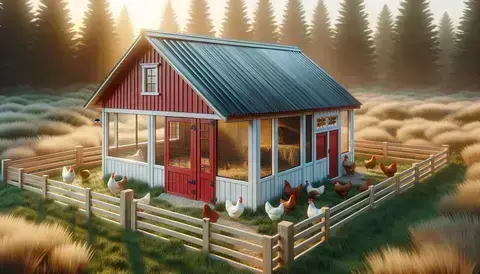
2. The Modern Minimalist: Features clean lines and a monochrome color scheme. Its simplicity is its strength, requiring minimal materials like sleek wood panels and metal for framing. Ideal for urban backyards.
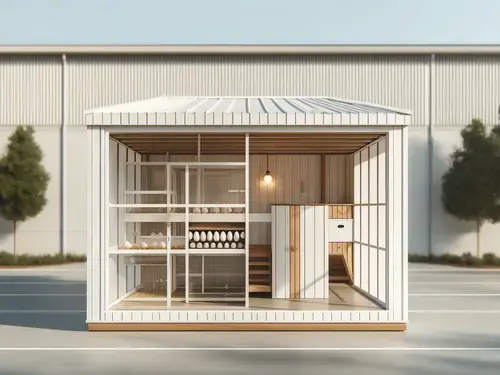
3. The Urban Compact: Designed for small spaces, this coop maximizes vertical space. Use lightweight materials and incorporate vertical nesting boxes and a small footprint. Perfect for city dwellers with limited outdoor space.

4. The Rustic Retreat: Emphasizes natural materials and a cozy feel. Build it with reclaimed wood and add personal touches like flower boxes. It blends well in a country garden, providing a warm home for chickens.

5. The Eco-Friendly Haven: Built with recycled materials and features like a green roof. It's effective for its sustainability and self-sufficiency. Focus on renewable resources and energy-efficient design elements.
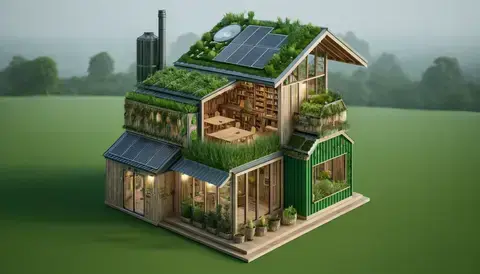
6. The High-Tech Hub: Incorporates technology for automatic feeding, watering, and egg collection. Use modern materials and integrate smart systems for climate control. Appeals to tech-savvy chicken owners.
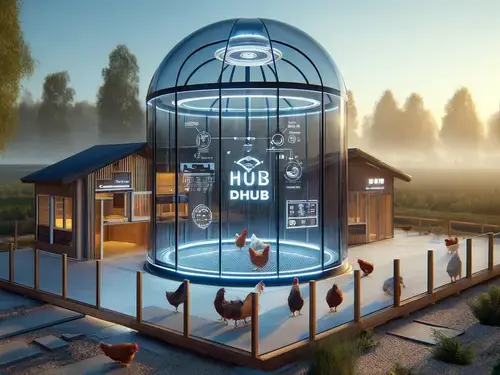
7. The Cozy Cottage: Small and charming, with attention to decorative details. Wooden construction with a quaint design makes it a delightful addition to any garden. It’s inviting for both chickens and viewers.
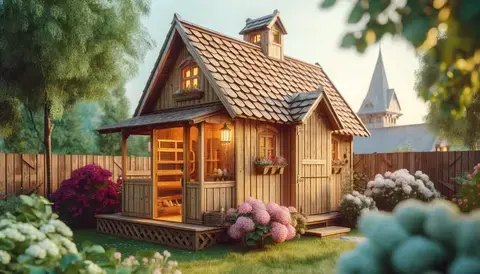
8. The Luxe Loft: High-end materials and design, offering deluxe accommodations for chickens. Think of using polished wood, glass, and even indoor lighting. It's about style as much as function.
9. The DIY Delight: Simple, cost-effective, and customizable. Made from readily available materials, it allows for personal creativity. Ideal for beginners or those on a budget.
10. The Pastoral Palace: Spacious and sturdy, designed for larger flocks. Use heavy-duty materials like treated lumber and strong mesh. Includes multiple access points for ease of maintenance.
11. The Scandinavian Simplicity: Features minimalist design and functionality with a focus on light and space. Utilize light wood and keep the layout open. Ideal for those who appreciate understated design.
12. The Industrial Chic: Utilizes metal and reclaimed materials for a modern, rugged look. Focus on durability and easy cleaning. Suitable for urban environments with an industrial aesthetic.
13. The Cottage Garden Coop: Blends into garden settings with its quaint design and landscaping. Use wood and add garden paths, flower beds, or climbing plants. Enhances the beauty of a garden while providing a functional space for chickens.
14. The Upcycled Utopia: Made entirely from repurposed materials. It's eco-friendly and unique. Collect old windows, doors, and pallets. Each coop becomes a one-of-a-kind creation.
15. The Country Cabin: Rustic and solid, with a log cabin aesthetic. Build with logs or wood with a natural finish. It’s perfect for rural settings, offering a durable shelter for chickens.
16. The Sleek and Stylish: Modern with a focus on aesthetics. Use high-gloss finishes and incorporate unconventional shapes or colors. Appeals to those looking to make a statement in their backyard.
17. The Functional Farmhouse: Combines traditional farmhouse style with modern functionality. Spacious with a focus on easy access for cleaning and egg collection. Use classic farmhouse elements like board and batten siding.
18. The Avian Oasis: Designed with the chicken's natural behaviors in mind. Include features like dust baths, perches at different heights, and plenty of space to roam. Mimic a natural habitat for happier, healthier chickens.
19. The Quirky Quarters: Unconventional and fun, with a focus on whimsical design. Let your imagination lead, using bold colors and creative structures. It’s a coop that stands out and sparks conversation.
20. The Pallet Paradise: Economical and easy to build, using pallets as the primary material. Ideal for DIY enthusiasts. It’s customizable and can be expanded as needed.
21. The Budget-Friendly Build: Simple, cost-effective, yet functional. Focus on essential needs like protection and ventilation. Use affordable materials like plywood and PVC.
22. The Contemporary Craftsman: Merges Craftsman style with modern needs. Features detailed woodworking and sturdy construction. Use quality materials and emphasize craftsmanship.
23. The Mobile Mansion: Portable and practical, allowing you to move the coop across your land. Build on a trailer or with wheels. Great for rotational grazing.
24. The Heritage Homestead: Classic design inspired by vintage coops. Use traditional materials and techniques for authenticity. It’s a nod to the past, providing timeless elegance and functionality.
25. The Space-Saver Special: Ideal for very small outdoor spaces, focusing on compact design. Utilize every inch of space efficiently, with fold-out panels or multi-level roosting and nesting areas.
Contemporary Aspects of Chicken Coop Designs
- Discussion on how technology, environmental concerns, and changing lifestyles influence chicken coop design today.
- The role of sustainability and eco-friendliness in modern designs.
- Innovations in materials and construction techniques.
Technology Influence
Today's chicken coops often include technology for easier care and better chicken health. Automated systems for feeding, watering, and egg collection save time and ensure chickens have what they need. Security cameras and mobile apps let owners check on their flock from anywhere. Smart sensors can monitor temperature and humidity, adjusting the environment automatically for optimal comfort.
Environmental Concerns
Environmental sustainability is a big focus in modern coop designs. Eco-friendly coops might use solar panels to power lights or automated systems. Rainwater collection systems can provide water for chickens or gardens. Many coops are built with recycled or upcycled materials, reducing waste. Designs often include green roofs or gardens, helping to insulate the coop and provide fresh greens for chickens.
Changing Lifestyles
As more people embrace backyard chicken keeping, there's a demand for coops that fit various lifestyles and spaces. Urban chicken keepers need compact, efficient designs that make the most of small spaces. Portable coops allow flexibility in using garden space and help keep the ground healthy. People also want coops that look good in their yard, leading to designs that are as much about aesthetics as function.
Sustainability and Eco-friendliness
Sustainability is key in many aspects of life, including chicken coop design. Modern coops often aim to be self-sufficient, minimizing environmental impact. This can mean designing coops that are energy-efficient, use sustainable materials, and incorporate systems that support a closed-loop ecosystem, such as composting chicken waste for garden fertilizer.
Innovations in Materials and Construction
New materials and construction techniques are making coops better and easier to build. Composite materials offer durability and resistance to rot without the need for toxic treatments. Lightweight metals can provide security from predators while allowing for movable designs. Insulation technologies help keep coops warm in winter and cool in summer, improving the welfare of the chickens. Modular designs allow for easy expansion as flock sizes grow.
Together, these contemporary aspects reflect a holistic approach to chicken coop design, where functionality, sustainability, and lifestyle needs converge. The result is a range of innovative coops that cater to the diverse needs of modern chicken keepers while addressing environmental concerns.
Designing Your Own Chicken Coop
- Basic steps to consider: planning for space, choosing materials, ensuring proper ventilation and protection, and adding personal touches.
- Tips for beginners on getting started with their first coop project.
Designing Your Own Chicken Coop
Basic Steps to Consider
Planning for Space: Decide how many chickens you want to keep, as this will determine the size of your coop. Each chicken needs about 2-3 square feet inside the coop and 8-10 square feet in the outdoor run. Consider future expansions if you plan to add more chickens later.
Choosing Materials: Look for durable, weather-resistant materials. Treated wood can resist rot, but ensure it's safe for animals. Metal can be used for the roof to provide extra protection from predators and the elements. Recycled materials can also be a cost-effective and eco-friendly option.
Ensuring Proper Ventilation: Good airflow is crucial to keep the coop free from dampness and to regulate temperature. Include vents or windows that can be opened or closed depending on the weather. Ensure they are positioned to prevent drafts directly on the chickens.
Protection: Secure the coop against predators with sturdy construction and hardware cloth instead of chicken wire. Bury the wire around the perimeter to prevent digging. Locks on doors and nests help keep your chickens safe.
Personal Touches: Make the coop your own by adding unique features. This could be anything from painting the coop to match your house to creating themed decoration. Adding plantings around the coop can integrate it into your garden.
Tips for Beginners
Start Small: If you're new to chicken keeping, begin with a smaller coop and a few chickens. It's easier to manage and gives you a chance to learn as you go.
Use Plans: There are many free and paid coop designs available. Using a plan can help you avoid common design mistakes and ensure your coop meets all your chickens' needs.
Consider the Location: Place your coop in a high, well-drained area to avoid flooding. Ensure it gets sunlight but also has shade to protect chickens from heat.
Think About Maintenance: Design your coop for easy cleaning. Hinged roofs, removable trays, and doors that allow you to walk in will make maintenance simpler.
Ask for Help: Don’t hesitate to seek advice from experienced chicken keepers. Online forums, local farming groups, and books on chicken keeping can be great resources.
Designing and building your chicken coop can be a rewarding project. With proper planning and a bit of creativity, you can create a safe, comfortable home for your chickens that also adds beauty to your backyard.
Key Takeaways on Chicken Coop Designs
- Summary of what makes a good chicken coop design.
- The importance of balancing functionality with aesthetics.
- Encouragement for readers to explore designing their own coop or choosing a design that best fits their needs.
Key Takeaways on Chicken Coop Designs
What Makes a Good Chicken Coop Design:
- Safety and Protection: A well-designed coop keeps chickens safe from predators and extreme weather conditions.
- Adequate Space: Chickens need enough room to move, rest, and lay eggs without crowding, which is vital for their health and happiness.
- Proper Ventilation: Good air circulation is essential to keep the coop dry and prevent respiratory issues.
- Ease of Access: Coops should be designed for easy access to facilitate cleaning, feeding, and egg collection.
- Durability: Choosing the right materials can ensure the coop withstands the elements and lasts for years.
Balancing Functionality with Aesthetics:
A chicken coop doesn't just have to be practical; it can also be a beautiful addition to your garden or backyard. Today's coop designs often incorporate both functionality and aesthetics, reflecting the owner's style and complementing the surrounding landscape. By paying attention to design details and finishes, you can create a coop that's not only comfortable for your chickens but also a visual delight.
Encouragement for Designing Your Own Coop:
Designing your own chicken coop can be a fulfilling project, allowing you to tailor the space precisely to your needs and those of your chickens. Whether you start from scratch or adapt existing designs, the process can be a creative and enjoyable way to engage with your backyard farming experience. Don't be afraid to experiment and innovate; your perfect chicken coop design is one that meets your functional requirements while also sparking joy every time you see it.
Remember, the best chicken coop is one that considers the well-being of the chickens, makes your chores easier, and adds value to your outdoor space. We encourage readers to dive into the design process, whether that means crafting a custom coop or selecting and customizing a pre-existing design. With the right approach, you can create a functional, beautiful space that your chickens will love calling home.
